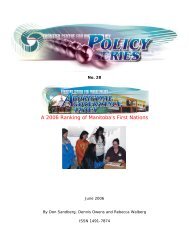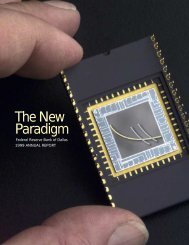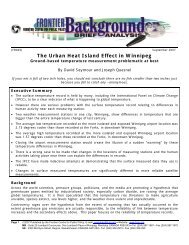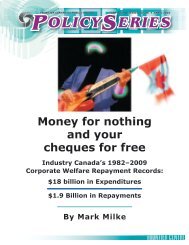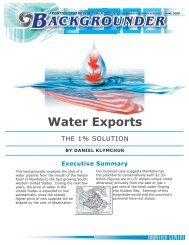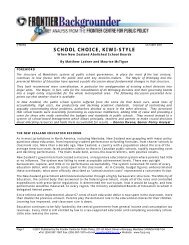The New Paradigm - Federal Reserve Bank of Dallas
Create successful ePaper yourself
Turn your PDF publications into a flip-book with our unique Google optimized e-Paper software.
21<br />
Many <strong>of</strong> the new technologies have the same cost structure.<br />
S<strong>of</strong>tware companies spend millions on programmers<br />
who write line after line <strong>of</strong> computer code. Additional<br />
copies are virtually costless if downloaded via the Internet.<br />
In <strong>Dallas</strong>, the average cost <strong>of</strong> a minute <strong>of</strong> cell phone service<br />
falls from nearly 50¢ at 60 minutes per month to just a<br />
dime for 1,000 minutes. (See Exhibit 14a.) Once they invest<br />
in equipment, Internet service providers can add new subscribers<br />
for very little. <strong>The</strong> Scandinavian countries, the<br />
United States, Canada and Australia show the deepest penetration<br />
<strong>of</strong> Internet households per 1,000 residents, and<br />
they also have the lowest access fees. (See Exhibit 14b.)<br />
<strong>The</strong> $9 trillion U.S. economy is sprawling and diverse,<br />
with millions <strong>of</strong> companies. Some operate with increasing<br />
costs, others with decreasing costs. Fast growth in the<br />
<strong>New</strong> Economy creates more <strong>of</strong> the latter with each passing<br />
year. This alters the cost structure for the nation as a<br />
whole, even though a large number <strong>of</strong> traditional industries<br />
continue to exist.<br />
Spillovers add to the economy-wide savings. Computers,<br />
s<strong>of</strong>tware, high-speed data transmission and other new technologies<br />
lower the cost <strong>of</strong> doing business across wide swaths<br />
<strong>of</strong> the economy. (See Exhibit 15 on page 22.) Even such oldline<br />
industries as steel, textiles and automobiles are taking<br />
advantage <strong>of</strong> Information Age cost cutting. As a result, the<br />
overall economy’s cost structure can slope downward, even<br />
though many companies face decreasing returns to scale.<br />
Give Growth a Chance<br />
<strong>The</strong> <strong>New</strong> Economy isn’t a mirage. <strong>The</strong> microprocessor<br />
set <strong>of</strong>f a revolution that spawned a new vitality and challenged<br />
old notions about the economy’s limits. And there’s<br />
no end in sight. Industries and applications already in the<br />
marketplace will take decades—in some cases, a century<br />
or more—to fully mature. More spillovers from the microprocessor,<br />
and the innovations those technologies will<br />
beget, are just over the horizon.<br />
We think <strong>of</strong> the years straddling 1900 as wonderfully<br />
inventive times, personified by Edison, who in bringing<br />
electricity to the market launched a revolution. If anything,<br />
our times teem with unmatched potential for technological<br />
change. Edison gave the world a substitute for physical<br />
power. Today’s entrepreneurs bring to the fore a more<br />
Want to make a movie? Shooting a one-hour flick on standard celluloid<br />
film requires three dozen 400-foot reels <strong>of</strong> 16-mm film at $150<br />
each. Add processing and editing fees and the bill grows to nearly<br />
$120,000, even before the cast and crew are paid. Or buy Canon’s<br />
XL1 digital video camera for about $4,000, eliminate<br />
the processing fees and edit it<br />
yourself on an Apple Cinema Display<br />
powered by a PowerMac G4 ($6,500 for<br />
the two), using Adobe Systems’ Premiere<br />
s<strong>of</strong>tware package (about $600). Cost the<br />
microcinema way: about $11,000—90 percent<br />
less than with yesterday’s technology. And you<br />
can make your next movie for the $10 cost <strong>of</strong> a twohour<br />
DV cassette.<br />
Cyrano Sciences has developed a handheld device with sensors that<br />
detect food spoilage, volatile compounds, auto emissions, leaking<br />
pipes, land mines and strep bacteria. Also in the works is an inexpensive<br />
“nose chip” that could be embedded in home appliances.<br />
<strong>Federal</strong> <strong>Reserve</strong> <strong>Bank</strong> <strong>of</strong> <strong>Dallas</strong> 1999 ANNUAL REPORT




